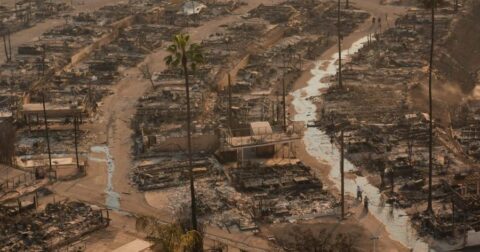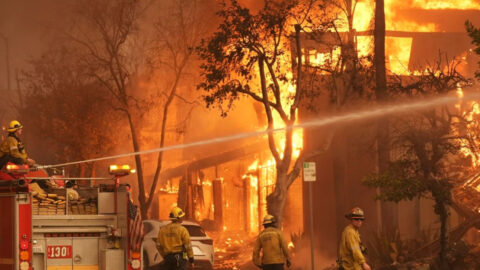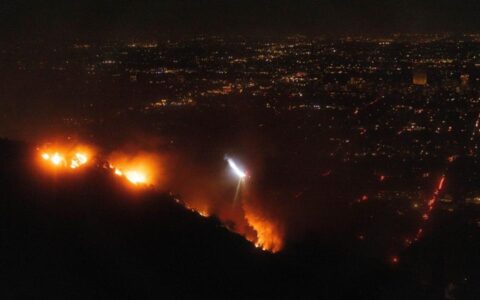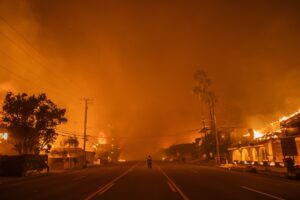Los Angeles Wildfires: A Community in Crisis
Los Angeles is currently grappling with one of the most severe wildfire crises in recent history. A series of blazes, fueled by dry conditions and powerful Santa Ana winds, have spread rapidly across the region. As of today, more than 35,000 acres have been consumed, and the fires remain largely uncontained. The Palisades Fire, which started in the coastal hills, has emerged as the most destructive, forcing over 150,000 people to flee their homes. Tragically, reports confirm 11 fatalities and dozens of injuries, making this disaster not only an environmental threat but also a profound humanitarian crisis.
Extent of the Damage

The wildfires have wrought immense destruction, burning through residential neighborhoods and commercial areas alike. Over 10,000 structures have been destroyed, including homes of several notable residents in the Pacific Palisades and Malibu areas. The famous coastal highway, Pacific Coast Highway (PCH), has been partially shut down to allow emergency services better access to affected areas. Several schools and businesses have also sustained severe damage, further straining local resources.
In addition to property damage, the fires have severely impacted local wildlife, with conservationists expressing concern about the long-term effects on endangered species in the nearby mountains. Thousands of acres of forestland, including parts of the Santa Monica Mountains National Recreation Area, have been reduced to ashes.
Evacuation Efforts and Challenges

The evacuation process has been chaotic, with more than 150,000 residents forced to leave their homes. Shelters have quickly reached full capacity, leaving some evacuees scrambling to find temporary accommodations. Nearby hotels are fully booked, and emergency personnel are working tirelessly to assist those in need.
Firefighters are facing an uphill battle due to limited resources and challenging terrain. The dry climate, combined with strong winds, has made it nearly impossible to fully contain the flames. To add to the difficulty, water supply issues have arisen in several parts of the city, slowing down firefighting efforts. Despite these obstacles, nearly 2,000 firefighters, supported by air tankers and helicopters, continue to combat the blazes day and night.
Community Response
Amid the chaos, the local community has come together to support those affected. Notably, Australian model and podcast host Chloe Fisher launched a fundraiser to aid displaced families, raising $14,000 in just 24 hours. Several other local influencers and public figures have also stepped forward to provide assistance, offering shelter and supplies to those in need.
In addition, nonprofit organizations, including the American Red Cross and Los Angeles Food Bank, have mobilized their resources to deliver essential aid. Volunteers have been distributing food, water, blankets, and medical supplies to evacuees. The outpouring of support from the community has provided a glimmer of hope amid the ongoing crisis.
Government Actions
In response to the escalating situation, President Biden approved federal disaster assistance, enabling additional funds and resources to be allocated to firefighting and relief efforts. Firefighters from neighboring states, including Arizona and Nevada, have also joined the efforts.
However, not everyone is satisfied with the government’s response. Kristin Crowley, Chief of the Los Angeles Fire Department (LAFD), recently criticized the city’s leadership for budget cuts that have hampered the department’s preparedness. “Our department has been screaming to be properly funded for years,” she stated in a press briefing. The lack of sufficient funding has become a point of contention as residents demand more robust preventive measures and better fire management infrastructure.In response to the escalating situation, President Biden approved federal disaster assistance, enabling additional funds and resources to be allocated to firefighting and relief efforts. Firefighters from neighboring states, including Arizona and Nevada, have also joined the efforts.
However, not everyone is satisfied with the government’s response. Kristin Crowley, Chief of the Los Angeles Fire Department (LAFD), recently criticized the city’s leadership for budget cuts that have hampered the department’s preparedness. “Our department has been screaming to be properly funded for years,” she stated in a press briefing. The lack of sufficient funding has become a point of contention as residents demand more robust preventive measures and better fire management infrastructure.
Health and Safety Concerns
Beyond immediate physical destruction, the wildfires pose serious health risks. The dense smoke has led to hazardous air quality across Los Angeles County, prompting officials to issue health advisories. Residents are advised to stay indoors, use air purifiers, and wear masks if they need to venture outside.
Additionally, widespread power outages have affected nearly 1.6 million homes, further complicating the lives of those in evacuation zones. Hospitals are on high alert, with an increase in patients experiencing respiratory problems due to smoke inhalation. Health experts warn that prolonged exposure to poor air quality can lead to long-term health issues, particularly for children, the elderly, and those with preexisting respiratory conditions.
Conclusion

As Los Angeles faces this unprecedented wildfire crisis, the resilience and solidarity of its residents will be key to recovery. While firefighting efforts continue, local and federal authorities must work hand in hand to prevent future tragedies of this scale. Strengthening emergency preparedness, increasing funding for fire services, and raising public awareness about fire safety are crucial steps in protecting communities from future disasters.



